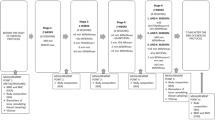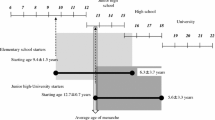Summary
The effects of walking and aerobic dancing on the bones of 73 recently postmenopausal women have been compared by photon absorptiometry of the distal radius with a control group who did not exercise. The period of observation was six months. Results showed that the control group and the walking group lost statistically significant amounts of bone mineral content (1.6%, and 1.7% respectively), but that the dancing group did not (0.8%). The control group did not show a significant increase in the bone width (0.9%), but both the dancing (1.3%) and walking (1.6%) groups did. Changes in the cross-sectional moment of inertia of the radius were estimated for each subject based on bone mineral content and bone width values. Both exercise groups experienced significant increases in this variable, while the control group did not. Plasma oestrogen levels were not influenced by exercise. The results support the hypothesis that mechanical loading due to exercise may be effective in preventing postmenopausal osteoporosis.
Résumé
Les auteurs ont comparé, par photo-absorptiométrie de l'extrémité inférieure du radius, les effets de la marche et de la danse «aerobic« sur l'os de 73 femmes récemment ménopausées en les comparant à un groupe de contrôle ne pratiquant aucun exercise. L'observation a porté sur une période de six mois. Les résultats montrent que le groupe de contrôle et celui qui pratique la marche présentent une déminéralisation osseuse statistiquement significative (1,6% et 1,7% respectivement), contrairement au groupe pratiquant la danse (0,8%). Il n'y a pas d'augmentation significative de la largeur de l'os dans le groupe de contrôle (0,9%), alors qu'elle est importante aussi bien dans le groupe de danse (1,3%) que dans le groupe de marche (1,6%). On a calculé chez chaque sujet, à l'aide des mesures de la teneur en minéraux et de la largeur de l'os, le moment d'inertie d'une section horizontale du radius. Les deux groupes pratiquant un exercise présentent une augmentation significative de cette variable, tandis qu'il n'y en a pas dans le groupe de contrôle. Le taux d'oestrogène plasmatique n'est pas influencé par l'exercise. Ces résultats confirment l'hypothèse selon laquelle les contraintes mécaniques entraînées par l'exercise pourraient prévenir efficacement l'ostéoporose post-ménopausique.
Similar content being viewed by others
References
Mazess RB, Cameron JR (1973) Bone mineral content in normal U.S. whites. In: International Conference on Bone Mineral Measurement, pp 228–238. Chicago, Illinois: U.S. Department HEW
Moore WT, Shapiro JR, Jorgensen H, Reid J, Epps CH, Whedon GD (1975) The evaluation of bone density findings in normal populations and osteoporosis. Transactions of the Am Clin Climatol Assoc, 86: 128–138
Karjalainen P, Alhava EM (1977) Bone mineral content of the forearm in a healthy population. Acta Radiol Therapy Phys Biology 16: 199–208
Cohn SH, Vaswani A, Zanzi I, Ellis KJ (1976) Effect of aging on bone mass in adult women. Am J Physiol 230: 143–148
Aloia JF, Cohn SH, Babu T, Abesamis C, Kalici N, Ellis K (1978) Skeletal mass and body composition in marathon runners. Metabolism 27: 1793–1796
Dalen N, Olsen KE (1974) Bone mineral content and physical activity. Acta Orthop Scand 45: 170–174
Nilsson BE, Westlin NE (1971) Bone density in athletes. Clin Orthop 77: 179–182
Nilsson BE, Anderson SM, Hadrup T (1978) Ballet dancing and weight lifting-effects on bone mineral content. Am J Roentgenol 131: 541
Aloia JF, Cohn SH, Ostuni JA, Cane R, Ellis K (1977) Prevention of involutional bone loss by physical exercise. Calc Tiss Res Suppl 24: R1
Smith EL, Jr, Babcock SW (1973) Effects of physical activity on bone loss in the aged. Med Sci Sports Exec 5: 68
Smith EL, Jr, Reddan W (1976) Physical activity — a modality for bone accretion in the aged. Am J Roentgenol. 126: 1297
Smith EL, Jr, Reddan W, Smith PE (1981) Physical activity and calcium modalities for bone mineral increase in aged women. Med Sci Sports Exerc 13: 60–64
Smith DM, Khairi MRA, Norton J, Johnston CC (1976) Age and activity effects on rate of bone mineral loss. J Clin Invest 58: 716–721
Sorensen J (1979) Aerobic Dancing. New York, Rawson, Wade Publishers, Inc.
Cameron JR, Sorenson J (1963) Measurement of bone mineral in vivo: an improved method. Science 142: 230–232
Sorenson JA, Cameron JR (1967) A reliable in vivo measurement of bone mineral content. J Bone Joint Surg [Am] 49: 481–497
Goldsmith NF, Johnston JO, Ury H, Vose G, Colbert C (1971) Bone-mineral estimation in normal and osteoporotic women. J Bone Joint Surg [Am] 53: 83–100
Wilson CR (1977) Bone-mineral content of the femoral neck and spine versus the radius or ulna. J Bone Joint Surg [Am] 58: 665–669
Martin RB, Burr DB (1983) Non-invasive measurement of long bone cross-sectional moment of inertia by photon absorptiometry. J Biomech (in press)
Butcher RL (1977) Changes in gonadotropins and steroids associated with unilateral ovariectomy of the rat. Endocrinology 101: 830–840
Clarke HH, Clarke DH (1978) Development al and Adapted Physical Education (2nd ed) Englewood Cliffs, N.J.: Prentice-Hall
Martin RB, Burr DB (1982) Does bone-mineral content reflect age-related changes in the mechanical properties of the distal radius? Transactions of the 28th Annual Meeting, Orthopaedic Research Society New Orleans, Jan. 19–21: 107
White MK (1981) The effects of walking and aerobic dancing on the skeletal and cardiovascular systems of postmenopausal females. Doctoral dissertation, West Virginia University, Morgantown, WV
Lewis S, Haskell WL, Wood PD, Manoogian N, Bailey JE, Pereira MB (1976) Effects of physical activity on weight reduction in obese middle-aged women. Am J Clin Nutr 29: 151–156
Luria MH, Koepke KR (1975) The physical conditioning effects of walking. J Sports Medicine and Physical Fitness 15: 272–274
Pollack ML, Miller HS, Janeway R, Linnerud AC, Robertson B, Valentino R (1971) Effects of walking on body composition and cardiovascular function of middle-aged men. J Appl Physiol 30: 126–130
Khairi MRA, Johnston CC (1978) Exponential bone loss in postmenopausal women. In: International Conference on Bone Mineral Measurement, p 543. Ontario, Canada: U.S. Department HEW
Kuhlencordt F, Ringe JD, Kruse H-P, Roth AV (1973) Bone mineral determination of radius, ulna, and finger-bones by 125 I photon absorptiometry on healthy persons. In: International Conference on Bone Mineral Measurement, pp 277–281. Chicago, Illinois: U.S. Department HEW
Smith EL, Cameron JR (1972) Interpretation of fracture index charts. Norland-Cameron Bone Mineral Analyzer Applications. Note No. 1
Goldsmith NF (1973) Normative data for the osteoporosis prevalence survey, Oakland, California, 1969–1970. In: International Conference on Bone Mineral Measurement, pp 239–344 Chicago, Illinois: U.S. Department HEW. 239
Smith DM, Khairi MRA, Johnston CC, Jr (1973) Mineral loss with aging measured prospectively by the photon absorption technique. In: International Conference on Bone Mineral Measurements, pp 268–276. Chicago, Illinois: U.S. Department HEW
Carlson DS, Armelagos GJ, VanGerven DP (1976) Patterns of age-related cortical bone loss (osteoporosis) within the femoral diaphysis. Human Biol 48: 295–314
Martin RB, Atkinson PJ (1977) Age and sex-related changes in the structure and strength of the human femoral shaft. J Biomech 10: 223–231
Martin RB, Picket JC, Zinaich S (1980) Studies of skeletal remodeling in aging men. Clin Orthop 149: 268–282
Smith RW, Jr, Walker RR (1964) Femoral expansion in aging women: Implications for osteoporosis and fractures. Science 145: 156–157
Burr DB, Martin RB (1983) Lower extremity loads stimulate bone formation in the vertebral column: Implications for osteoporosis. Spine (in press)
Author information
Authors and Affiliations
Rights and permissions
About this article
Cite this article
White, M.K., Martin, R.B., Yeater, R.A. et al. The effects of exercise on the bones of postmenopausal women. International Orthopaedics 7, 209–214 (1984). https://doi.org/10.1007/BF00266829
Issue Date:
DOI: https://doi.org/10.1007/BF00266829




